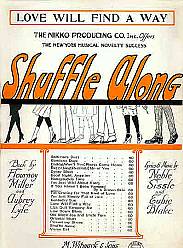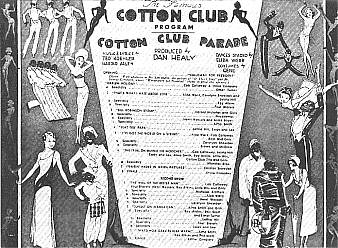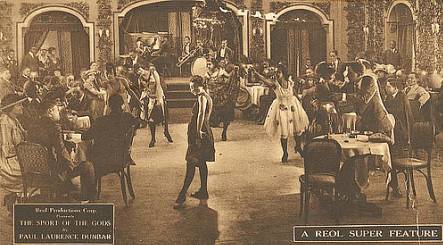Stop music: SQUARE button.
Play music: ARROW button.

Broadway show by Eubie Blake &
Noble Sisle
(sheet music, 1919).
When the Negro Was in Vogue
Selected Comments by
Langston Hughes and Wallace Thurman
Langston Hughes on Shuffle Along
The 1920's were the years of Manhattan's black Renaissance. It began with Shuffle Along, Running Wild, and the Charleston. Perhaps some people would say even with The Emperor Jones, Charles Gilpin, and the tom-toms at the Provincetown. But certainly it was the musical revue, Shuffle Along, that gave a scintillating send-off to that Negro vogue in Manhattan, which reached its peak just before the crash of 1929, the crash that sent Negroes, white folks, and all rolling down the hill toward the Works Progress Administration.
Shuffle Along was a honey of a show. Swift, bright, funny, rollicking, and gay, with a dozen danceable, singable tunes. Besides, look who were in it: The now famous choir director, Hall Johnson, and the composer, William Grant Still, were a part of the orchestra. Eubie Blake and Noble Sissle wrote the music and played and acted in the show. Miller and Lyles were the comics. Florence Mills skyrocketed to fame in the second act. Trixie Smith sang "He May Be Your Man But He Comes to See Me Sometimes." And Caterina Jarboro, now a European prima donna, and the internationally celebrated Josephine Baker were merely in the chorus. Everybody was in the audience--including me. People came back to see it innumerable times. It was always packed. . . . When I saw it, I was thrilled and delighted. . . . It gave just the proper push--a pre-Charleston kick--to that Negro vogue of the 20's, that spread to books, African sculpture, music, and dancing.
From The Big Sea by Langston Hughes (New York: Hill and Wang, 1940)

Cotton Club Program (1920s).
Langston Hughes on Whites in Harlem
White people began to come to Harlem in droves. For several years they packed the expensive Cotton Club on Lenox Avenue. But I was never there, because the Cotton Club was a Jim Crow club for gangsters and monied whites. They were not cordial to Negro patronage, unless you were a celebrity like Bojangles. So Harlem Negroes did not like the Cotton Club and never appreciated its Jim Crow policy in the very heart of their dark community. Nor did ordinary Negroes like the growing influx of whites toward Harlem after sundown, flooding the little cabarets and bars where formerly only colored people laughed and sang, and where now the strangers were given the best ringside tables to sit and stare at the Negro customers--like amusing animals in a zoo.
From The Big Sea by Langston Hughes (New York: Hill and Wang, 1940)
Langston Hughes on "when Harlem was in vogue"
It was a period when, at almost every Harlem upper-crust dance or party, one would be introduced to various distinguished white celebrities there as guests. It was a period when almost any Harlem Negro of any social importance at all would be likely to say casually: "As I was remarking the other day to Heywood--," meaning Heywood Broun. Or: "As I said to George--," referring to George Gershwin. It was a period when local and visiting royalty were not at all uncommon in Harlem. And when the parties of A'Lelia Walker, the Negro heiress, were filled with guests whose names would turn any Nordic social climber green with envy. It was a period when Harold Jackman, a handsome young Harlem school teacher of modest means, calmly announced one day that he was sailing for the Riviera for a fortnight, to attend Princess Murat's yachting party. It was a period when Charleston preachers opened up shouting churches as sideshows for white tourists. It was a period when at least one charming colored chorus girl, amber enough to pass for a Latin American, was living in a pent house, with all her bills paid by a gentleman whose name was banker's magic on Wall Street. 1t was a period when every season there was at least one hit play on Broadway acted by a Negro cast. And when books by Negro authors were being published with much greater frequency and much more publicity than ever before or since in history. It was a period when white writers wrote about Negroes more successfully (commercially speaking) than Negroes did about themselves. It was the period (God help us!) when Ethel Barrymore appeared in blackface in Scarlet Sister Mary! It was the period when the Negro was in vogue.
From The Big Sea by Langston Hughes (New York: Hill and Wang, 1940)

Harlem cabaret in The Sport of the Gods (film 1921)
based on Paul Laurence Dunbar's novel by the same name (1902).
Wallace Thurman on Harlem's Night Life
. . . Harlem's famed night clubs have become merely side shows staged for sensation-seeking whites. . . . [T]hey cannot approximate the infectious rhythm and joy always found in a Negro cabaret.
Take the Sugar Cane Club on Fifth Avenue near 135th Street, located on the border of the most "low-down" section of Harlem. This place is visited by few whites or few "dicty" Negroes. Its customers are the rough-and-ready, happy-go-lucky more primitive type--street walkers, petty gamblers and pimps, with an occasional adventurer from other strata of society.
The Sugar Cane Club is a narrow subterranean passageway about twenty-five feet wide and 125 feet long. Rough wooden tables, surrounded by rough wooden chairs, and the orchestra stands, jammed into the right wall center, use up about three-quarters of the space. The remaining rectangular area is bared for dancing. With a capacity for seating about one hundred people, it usually finds room on gala nights for twice that many. The orchestra weeps and moans and groans as only an unsophisticated Negro Jazz orchestra can. A blues singer croons vulgar ditties over the tables to individual parties or else wah-wahs husky syncopated blues songs from the center of the floor. Her act over, the white lights are extinguished, red and blue spot lights are centered on the diminutive dancing space, couples push back their chairs, squeeze out from behind the tables and from against the wall, then finding one another's bodies, sweat gloriously together, with shoulders hunched, limbs obscenely intertwined and hips wiggling; animal beings urged on by liquor and music and physical contact. . . .
One particular place known as the Glory Hole is hidden in a musty damp basement behind an express and trucking office. It is a single room about ten feet square and remains an unembellished basement except for a planed down plank floor, a piano, three chairs and library table. The Glory Hole is typical of its class. It is a social club, commonly called dive, convenient for the high times of a certain group. The men are unskilled laborers during the day, and in the evenings they round up their girls or else meet them at the rendezvous in order to have what they consider and enjoy as a good time. The women, like the men, swear, drink and dance as much and as vulgarly as they please. Yet they do not strike the observer as being vulgar. They are merely being and doing what their environment and their desire for pleasure suggest. . . .
The other extreme of amusement places in Harlem is exemplified by the Bamboo Inn, a Chinese-American restaurant that features Oriental cuisine, a jazz band and dancing. It is the place for select Negro Harlem's night life, the place where debutantes have the coming out parties, where college lads take their co-eds and society sweethearts ands dignified matrons entertain. It is a beautifully decorated establishment, glorified by a balcony with booths, and a large gyroflector, suspending from the center of the ceiling, on which colored spotlights play, flecting the room with triangular bits of varicolored light. The Bamboo Inn is the place to see "high Harlem," just like the Glory Hole is the place to see "low Harlem." Well-dressed men escorting expensively garbed women and girls; models from Vanity Fair with brown, yellow and black skins. Doctors and lawyers, Babbitts and their ladies with fine manners (not necessarily learned through Emily Post), fine clothes and fine homes to return to when the night's fun has ended. . . .
When Harlem people wish to dance, without attending a cabaret, they go to the Renaissance Casino or to the Savoy, Harlem's two most famous public dance halls. The Savoy is the pioneer in the field of giving dance-loving Harlemites some place to gather nightly. It an elaborate ensemble with a Chinese garden (Negroes seem to have a penchant for Chinese food--there are innumerable Chinese restaurants all over Harlem), two orchestras that work in relays, and hostesses provided at twenty-five cents per dance for partnerless young men. The Savoy opens at three in the afternoon and closes at three in the morning. One can spend twelve hours in this jazz palace for sixty-five cents, and the price of a dinner or an occasional sustaining sandwich and drink. The music is good, the dancers are gay, and setting is conducive to joy.
From Negro Life in New York's Harlem by Wallace Thurman
(Girard, KS: Haldeman-Julius Publications, 1928)
Return to Nichols Home Page
Return to Jazz Age Literature/Culture
Background MIDI: "Ain't Misbehavin'" (1929) by Fats Waller, Harry Brooks, and Andy Razaf
Source: Ragtime Press
This page is for educational use only.